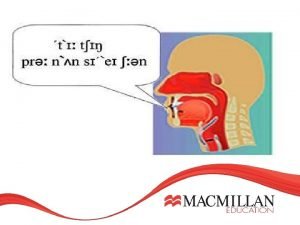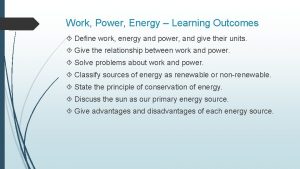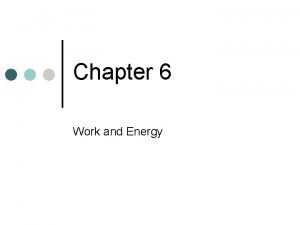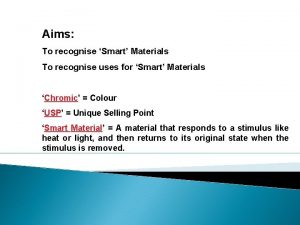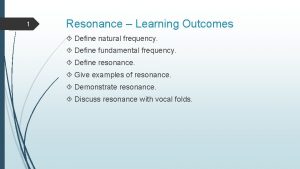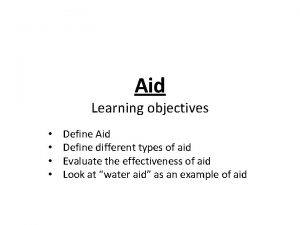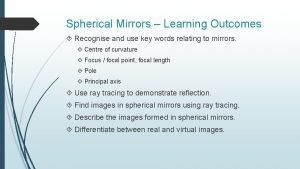1 Energy Learning Outcomes Define energy Recognise different













- Slides: 13

1 Energy – Learning Outcomes Define energy. Recognise different forms of energy. State the Principle of Conservation of Energy. Give examples of converting between different forms of energy. Demonstrate energy conversion. Solve problems about energy conversion. Give renewable and non-renewable sources of energy. Explain the Sun’s method of energy conversion.

2 Energy is the ability to do work. The main forms of energy are: potential – energy due to position, kinetic – energy due to motion, light – energy stored in photons, sound – energy stored in moving pressure waves, heat – vibrational and translational energy of particles, chemical – energy stored in / released from chemical bonds, nuclear – energy stored in / released from atomic bonds, electrical – energy of charged particles in a circuit, mass – energy condensed into particle form.

3 Conservation of Energy The Principle of Conservation of Energy states that energy can be neither created nor destroyed, but can be converted from one form to another. e. g. listening to music: electrical -> sound e. g. driving a car chemical -> kinetic e. g. making toast: electrical -> heat and light e. g. a falling object: potential -> kinetic

4 Potential Energy

5 Kinetic Energy

6 Loss in potential energy = gain in kinetic energy for a freefalling object. e. g. A 20 kg rock is rolled off a cliff face, falling 100 m before hitting the ground. What is its velocity as it hits the ground? e. g. A 5 m long pendulum is allowed to swing back and forth. If its greatest angle of swing is 20 o, how much vertical height does the pendulum gain at the top of its swing? What is its maximum velocity?

7 Brick A is dropped from a height 2 h, while an identical brick B is dropped from a height h. When brick A hits the ground it has: A. twice as much kinetic energy as brick B B. the same kinetic energy KE as brick B C. four times as much KE as brick B D. None of the above A 2 h B h

8 A truck initially at rest at the top of a hill is allowed to roll down. At the bottom its speed is 4 m/s. Next, the truck is again rolled down the hill, but this time it does not start from rest. It has an initial speed of 3 m/s at the top even before it starts going down the hill. How fast is it going when it gets to the bottom? A. 3 m/s B. 4 m/s C. 5 m/s D. 6 m/s E. 7 m/s

9 Collisions We know momentum is conserved in collisions. Kinetic energy is usually not conserved, as some is lost to heat and sound energy. Collisions where kinetic energy is conserved are called elastic collisions. Collisions where kinetic energy is not conserved are called inelastic collisions.

10 Collisions e. g. A mass of 5 kg travelling at 20 m s-1 collides with and sticks to a mass of 2 kg which is at rest. Find the velocity of the combined mass after the collision. Find the loss in kinetic energy. e. g. A small mass of 5 kg is suspended from a fixed point by a light string 2 m long. Another mass of 6 g moving horizontally at 100 m s-1 strikes the 5 kg mass and sticks to it. The combined mass then swings in a vertical plane. Find the greatest height it reaches.

11 Sources of Energy – Renewable Wind energy – kinetic energy of the wind. Solar energy – light energy emitted by the Sun. Hydroelectric energy – potential energy of falling water. Wave / tidal energy – kinetic energy of water pulled by the Moon. Biomass energy – chemical energy stored in food.

12 Sources of Energy – Non-Renewable Coal Oil Peat Gas – each of these are burned, converting stored chemical energy. Nuclear fission – splitting atoms to release nuclear energy. Nuclear fusion – fusing atoms to release nuclear energy.

13 Solar Energy
 Computer recognise only two discrete states
Computer recognise only two discrete states Recognise equal groups year 2
Recognise equal groups year 2 Recognise pronunciation
Recognise pronunciation Proper noun for day
Proper noun for day Sound energy definition
Sound energy definition Learning outcomes of work and energy
Learning outcomes of work and energy Expected outcome example
Expected outcome example Water cycle learning outcomes
Water cycle learning outcomes Notice writing objectives
Notice writing objectives Swot analza
Swot analza Rhymes learning outcomes
Rhymes learning outcomes Example of learning objectives
Example of learning objectives Photosynthesis takes place in the
Photosynthesis takes place in the Learning outcomes of photosynthesis
Learning outcomes of photosynthesis


